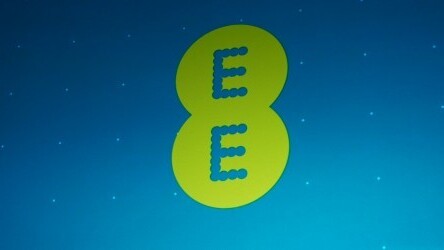
Mobile network operator EE announced earlier today that it would be doubling its 4G network speeds in 10 metropolitan areas across the UK before the beginning of this summer.
Top speeds would increase to 80 Mbps, while average connectivity would sit at roughly 20 Mbps for both new and existing subscribers.
The ‘double-speed’ 4G network will be rolled out to Birmingham, Bristol, Cardiff, Edinburgh, Glasgow, Leeds, Liverpool, London, Manchester and Sheffield initially, with additional cities being added in six-month intervals.
It’s all part of EE’s new target to hit 1 million 4G customers by the end of 2013 in the UK. It’s a tall order, given that the operator won’t even finish rolling out its standard 4G network until the end of 2014. We spoke to Fotis Karonis, Chief Technology Officer at EE, to discuss some of the problems facing the company at this time.
TNW: Why introduce ‘double-speed’ 4G connectivity now? Why not wait until the original roll-out is completed, or why didn’t you implement it with the initial launch last October?
Mobility is at the core. But mobility is also about a strong network experience. So we want to differentiate from the other networks by putting our network at the center. We’re investing and we’re making our ecosystem work in a real, IT-type of world now, because it’s application-based, it’s not just 3G with voice and text.
So the whole paradigm is shifting into a super content-driven world, which requires a continuous future-proof approach to go up in capacity. We have had limitations of course with cost, and limitations with physics moving from 2G to 3G. But now, it seems that we have broken that spiral.
4G is enabling this world of content, applications and communications. So we have got out of this spiral of the physical limitation. This is what we’re building. It’s a science.
So we are promoting a growing capability. The snapshot you see today is 80 Mbps capability, if you’re uncapped. These capabilities will provide what you see today or in a few months, in the summer and building for the future, as well as how this industry grows and how the hunger for video, replacing voice and applications, grows even further.
TNW: Other operators in the UK will be launching their own 4G networks later this year. Is ‘double-speeds’ an attempt to put some distance between you and them?
4G is like Pandora’s Box, you know? What we really want to do is stay ahead of the curve. One or two steps. By doing this, I think we’re two steps ahead.
So we’re investing in our skills, our people. I’m looking at the whole process end-to-end. The core is very important and we’re talking about speed on the front – what it appears on the consumer side – but we have also prepared a very robust core environment, an EE core environment, with full stability. The whole operation is working 100 percent with no incidents.
We have the security part of it, so we have built a component environment in the core, which enables all of this growth. So I think we have really invested in the right places, which gives us flexibility. We have the skill set now to influence the device manufacturers, to get the right devices, the right content inside with the right spectrum blend and the right functionality.
So I think we will continue to be ahead of the competition, absolutely.
TNW: So it’s not just about the speeds you can offer?
It’s not just about pressing the button because you have the right spectrum. It’s about preparing all of this in the background, and having the skills and the credibility to influence the huge external ecosystems of device manufacturers and developers.
We’re influencing different levers. Software companies, provisioning software, all of this stuff around CRM, it’s a very big environment which we’ve uplifted to be 4G. So I think we will always be ahead of the curve.
TNW: The other side of this problem concerns price, especially as other networks begin to launch their own 4G networks. How are you going to stay competitive in that regard?
It (our prices) will become smarter and smarter. It will be more adapted to the consumer. So if the speed grows and the capability of the network improves, we will probably link that with bundles for more GB per second, more capacity, more usage. So bundles like 2GB or 4GB, or 6GB, it doesn’t matter – the speed itself will draw interest.
It doesn’t mean that the price will be exponential, however. It will be step-by-step options. So users will need a little bit more bandwidth, or the capacity to download a HD movie – and the appetite will increase.
So first of all, our pricing strategy is about saturation. So we don’t want to have to say ‘What do we do, we’re in the new world, we haven’t predicted all of this demand and we don’t have enough GB transmission.’ So we’ve put in all of these boxes so that users can easily upgrade.
I’m not saying that the 4G EE offers will be unlimited, as it’s not easy and we don’t need that. But we will be increasing it in accordance with the needs of consumers. So we will build value through network differentiation, but also through capabilities. It’s not that it will be an exponential price increase; but 4G isn’t an endless resource either, that’s the issue.
TNW: One of the biggest stories recently was that in America, T-Mobile has decided to split the cost of the handset and the contract. Do you feel there are other models that EE can be adopted to promote these ‘double-speeds’?
Until now we were led a lot by the device manufactures. So by building a very strong network capability, we become more decisive and we have more credibility. We have a stronger negotiation power in the ecosystem between device manufacturer’s transmission and all of these other parts.
But I do believe that we are paying a bit too much. As an industry, as network operators. I’m not only talking about EE, but of the subsidizing margins that you see in Samsung and Apple devices across the world. Coming from the IT industry to the network industry, I find that very unbalanced.
In the UK, we have margins of 22, 23 percent, the industry standard. It’s a bit of an indirect channel and the device operators are getting a lot of the indirect costs, so I think in the future there might be a little more balance and detachment of the device options with the actual network capability.
But you’re right about the US, it shows a trend. If you need more data, you pay more.
TNW: EE has been very clear in the past about its 4G coverage here in UK. As the ‘double speed’ network is rolled out, how are you going to communicate that difference in quality to consumers?
We are a little bit ahead of the curve here. So first of all, the 4G is going to continue to roll out. We’re going to get to 55 percent at the end of the half-year and by the end of next year, population coverage in the UK will be 98 percent.
Now we are, we are taking the first 10 cities from our launch on October 30, and we’re putting them higher. That’s what’s coming up.
So while we are spreading across the UK geographically, we have selected those 10 metropolitan areas and will be improving them steadily. That doesn’t mean the other cities won’t come. It’s like a six-month Mexican wave!
TNW: I’m sure that will be the case, but how will you explain to consumers exactly what speeds they can expect in their area?
As I’m sitting in London, the average speed has in fact increased, because we have increased our transmission roadmap. So when it was launched on October 30, I would do my speed tests and it would be 8, 12, 16 Mbps. If you do it now, you can have speeds of up to 25, 30 Mbps.
So even if consumers haven’t got the super-duper 80 Mbps, they will have super-speeds. So, the other stuff will go even higher, 25-30 Mbps on average, with 80 Mbps and 92 Mbps peaks.
There is going to be a distinction, but the overall spread will be so fantastic because of the overall uplift, that overall coverage is going to be great anyway. So I don’t think there will be any panic at all.
TNW: Orange has found a lot of success in producing their own white-label handsets in order to drive down contract prices in Europe. Would EE consider producing their own 4G-ready hardware to do the same?
It’s a very good point. I’m not saying we are going to do that, but the price will be more democratized as we move on with the spectrum over time. The problem is that we don’t want to have too many types of ‘logistics’. It’s very hard to manage, but it’s also complicated for the customer.
But if we had a high-end, mid-range and low-end device? That does make sense.
Guys like BlackBerry and Huawei, they have devices that are hitting the low-end though. When we are talking to then, I can assure you, we are saying we need a good price, the lowest price. We’are also looking at all of the operating ecosystems, Android, iOS, BlackBerry and Windows Phone, to make sure we’re ticking those boxes.
Get the TNW newsletter
Get the most important tech news in your inbox each week.





